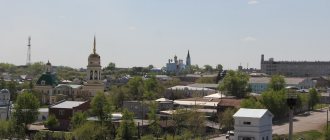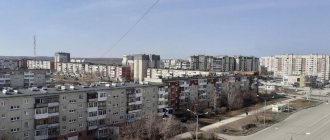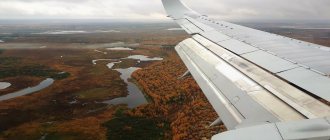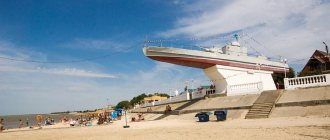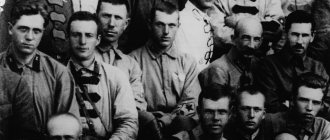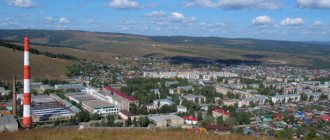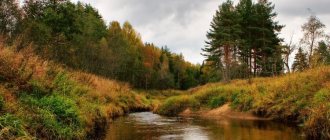The city of Kamensk-Uralsky in the Sverdlovsk region was founded more than three hundred years ago with the sole purpose of providing Russia with the ore necessary for casting cannons. The war with Sweden was in full swing, the country was sorely short of ammunition and ammunition, and natural resources were depleted. Peter the Great had no choice but to pay attention to the Ural deposits. In 1700, he gave the order to establish an iron foundry; a year later the plant was put into operation and produced the first batch of cannons and cannonballs. This is how the history of Kamensk began. For almost a hundred years the city was considered the center of exclusively heavy domestic industry. It is still called the capital of metallurgy today. But besides this, Kamensk-Uralsky has unique architectural and natural attractions that make it also the capital of culture. The city's attractions include beautiful buildings and cathedrals, picturesque parks and countryside landscapes, modern entertainment and recreation centers, museums and festivals. And first of all, these are the bells, the calling card of the city.
Bridge over the Sinara River
The first stop is at the ancient stone bridge over the Sinara River still within the Chelyabinsk region .
It’s a mystery to me: how does all this hold up?!
For us geologists, the main value of the bridge is that it is made of granite with oxidized pyrite crystals.
Wonderful place...
Why do you need to go to Kamensk-Uralsky? Weekend tour to the border of the Urals and Siberia
Border of the Urals and Siberia. Few people have seen it, but one of the settlements in our region through which it passes is the city of Kamensk-Uralsky. If you, like our team, come to Kamensk to set up a checkpoint here, you won’t find a place. The authorities and local residents did not consider it necessary to make such a mark, but you will be able to see a three-meter elk, a huge number of buildings included in the list of historical and cultural monuments, and walk among stunning natural monuments, much more ancient than the Kamensky plant...
So, in the process of preparing for the trip, we studied a bunch of sources - from Wikipedia to local history monographs and made a list of 21 points. Yes, yes, out of twenty-one. This is not the limit - Kamensk and its surroundings are replete with interesting places, which is why we focused only on the city’s borders.
By the way, we managed to visit 15 attractions from the list, and only for the reason that in the afternoon we split up - the female sex went to the architectural sites, the male - to nature.
Let me clarify that the daylight hours are still short - in warmer and brighter times, we probably wouldn’t have to pretend to be mad squirrels, but there would be a minus - that same nature in the summer is less accessible, and we’ll explain why later...
Go!
Points 1,2 : Management of the Kamensky plant and the Museum of Local Lore.
|
Now it is a small house with a rotunda, in which, together with neighboring, equally tiny, outbuildings, there is a Museum of Local Lore. The exposition is really very small; I walked through it, leisurely and taking photographs, in 20 minutes. The nice museum employees said that the excursion takes about 40 minutes, but there are museum maniacs who stick around for three hours.
What to watch?
— cast iron cannons, grenades and bombs: exactly the same ones were used by the troops of Peter I, by whose decree, in fact, the plant was founded;
— a model of the Kamensk fortress of the 1734 model, created by students of one of the local schools;
|
- an enchanting certificate of commendation for a student of the Kamensk four-year school from 1914 and a completely steampunk telegraph apparatus from about the same time;
— an exhibition of everyday life: what the interiors of townspeople looked like in different periods;
— a good assortment (for a small regional museum) of souvenirs for sale. I immediately became hooked on bells (you know that Kamensk is home to one of the few factories in Russia where bells are cast?). But, alas, the bells in the display case are imported (they refused to tell me where), because the smallest bells from a local factory weigh 6 kg. Tourists don't buy this;
|
- from the outside, in fact, you can thoughtfully examine the museum building itself - its central building, the building is austere and clean, just begging to be painted by a local artist. The building is a monument to the hand of Mikhail Malakhov 1825–1830, the chief architect of the Yekaterinburg Mining Factories Directorate, who participated in the reconstruction of the Kamensky factory city. Yes, by the way, such an eminent master worked here for a reason - it was the highest bonus to the plant for his devotion to the treasury and the emperor.
Overall: if you have a free hour, I recommend it! Considering the ticket price is 50 rubles. and the cost of photography is another 50, you can learn about the history of Kamensk for the price of a chocolate bar.
The cost of a full excursion is 100 rubles if 1 person goes. If the group is up to 10 people. - then 500 rubles. for everyone. Theoretically, you can sign up for it through the museum’s website, but something went wrong, I had to call, and it turned out that “you need to book an excursion at least a day in advance, or better yet, two days in advance, since a research assistant is not always on site.” We took a tour of the museum and decided to find out about the excursion to the bell factory; the staff of the local history museum also took us there (by the way, it’s free!). Here again there is a problem - you need to sign up for this excursion at least three days in advance, and only on weekdays. If the group is large, you can agree on Saturday (very lucky). The plant is closed on Sundays and holidays, so there are no excursions. Offended by the Internet for incorrect information, we go to breathe the air and mark the next checkpoint.
Point 3: Provision warehouses of the Kamensk plant. I sensed a catch when I saw the dates 1828–1958 in the Code of Historical and Cultural Monuments. The original warehouses were also built according to the design of the architect Malakhov, but the ruins of the former luxury that we see now are not Malakhov’s story at all. During the Soviet years, the warehouses were rebuilt several times, and the current pathos (or rather, its remains) is a reminder of the existence of a museum, library, drama theater, and cinema in this building. The warehouses were much simpler - without a second floor, wings at the ends, luxurious entrances and decor.
But it was these extensions that made it possible to call the building a monument of Soviet neoclassicism. The once beautiful building, now rather pitiful and useless to anyone, is slowly collapsing...
Bored and sad, we decided to feel like Indian Jones and went to the back of the warehouses to look for
Point 4. Remains of the old supporting wall of the dam, preserved since the beginning of the 18th century. (1700–1750)! We found it, but this is a “smart person should not repeat” experience. The Internet shows a bunch of pictures of this wall when searching for “attractions of Kamensk-Uralsky.” Do not believe! There is no official access there, and it is simply not visible behind the web of old trees. We found her only thanks to stubbornness and the fact that we did not spare clothes.
|
Having received a portion of oxygen in nature, we returned to culture.
Point 5. The architectural pearl of Kamensk is the Trinity Cathedral. The construction and reconstruction of the temple are recorded in many documents, so the chronology is well known to us. In fact, the existing temple is the fourth (I mean, including reconstruction after being in ruins). The form in which we know this temple was the result of the activities of the same Mikhail Malakhov.
|
But the history of the temple did not begin with Malakhov - back in the 1790s, permission was given for the construction of a stone three-altar church. The first stone was laid in 1792, but already in 1803 the church collapsed.
In 1813, the newly built temple was consecrated (it was built according to another project, the author of which, like the author of the first, we do not know). But even here there were problems - there was a threat of destruction of the bell tower. It was dismantled, and now, in 1821, the history of the Malakhovsky temple begins: according to his design, not only a new bell tower was built, but the entire building was rebuilt by 1828. Interesting facts:
- the current temple is eight-throne (that is, it has dedications to eight saints; in the Urals, even a temple with 5 thrones is rare), 5 thrones on the first floor, 3 more thrones on the second;
— the bell tower is decorated not with a standard dome with a cross, but with a tetrahedral obelisk, unique even for Malakhov;
- if you carefully examine the photo of Prokudin-Gorsky, who photographed the Kamensky plant in 1909, and modern photographs, some differences are visible: different forms of completion of the main dome, now there are no completions over the pediments and the refectory (there were crosses on pedestals), two additional altars at the main apse - were absent from Malakhov’s project;
- in the part over which the bell tower is built, a charming circular staircase has been preserved, which, according to a church employee, is original, from the beginning of the 19th century;
— between 1935 and the beginning of the 40s, the bell tower was used for training paratroopers.
In general, if you love architecture as much as I do, then the Trinity Church will be a must-visit place in Kamensk. It's just beautiful! For those who are not particularly interested in temple architecture, there is also something to see - I have already talked about the administration and warehouses, then there will be private mansions.
But before we finish the topic of iconic architecture, we'll take a look at the local dam.
Point 6! We approached the dam through the gullies at checkpoint 4, now it is right in front of us. The collection of monuments told us that the pavilion that adorns the dam dates back to the first half of the 19th century. and is a monument of classicism. Well, authorities sometimes make mistakes. Classicism is classicism, but this pavilion is not present in Prokudin-Gorsky’s photographs of 1909. And in Soviet photographs of the 1920s. he's not there either. How so? But the guidebooks simply forget to inform you that the dam and its above-ground part are completely different buildings, and in this case, the construction of the dam itself at the beginning of the 18th century. and the construction of the external pavilion in the middle of the 20th century are in no way connected.
|
From here it’s just a stone’s throw to the next point on the route:
Point 7. Church of the Transfiguration (territory of the Transfiguration Monastery, Kirova St., 3).
|
This church is clearly visible from the Trinity Cathedral, if you look to the north: it stands on a hill, and its bell tower is one of the highest places in the city. By the way, if you arrive in Kamensk on a weekday, there is a high probability of finding the archimandrite in the office, who may allow you to climb the bell tower. This is the sweetest thing, absolutely secular, because where, except from the bell tower, in the absence of observation platforms, can one view the entire city? I recommend!
|
The church was built between 1861 and 1878, when strict classicism was replaced by a style about which cultural historians, architects and art historians are still arguing. Russia was looking for its origins, and this was reflected in the construction of churches (in the Urals, however, 40 years later than in Central Russia). Either pre-Petrine baroque, or pseudo-Russian style, but beautiful and somehow soulful... In During the Soviet years, the church suffered quite a lot, but has now been restored very close to its original appearance.
Completing the topic with temples, from the Transfiguration of the Savior we went to Point 8 . Church of the Intercession (Revolutionnaya St., 45). The church is on another hill, opposite Preobrazhenskaya. A little younger - built in 1883, also in Russian style? Byzantine? Let the theoreticians understand the concepts, we are simply admiring the unusual architecture - the main part of the temple seems to stand separately from the hipped bell tower, unexpected against the backdrop of the domes of the Trinity Cathedral.
Total for religious architecture: if you are interested specifically in temples, then the three objects that we have described will be enough for you. If that’s not enough, in the Kamensk district there are a good dozen villages with amazing churches, some of which are being restored and are even already in operation, and some continue to be destroyed.
We will return to Kamensk and its architecture, now secular.
Item 9. Residential building at the address: st. Krasnykh Orlov, 36. Would you like to look at the “brick style”? That way. Want to see a unique layout? Here too! The house is not square, not rectangular, but pentagonal and very cute! There is no exact information about the construction of this house, but according to building plans and evidence from archives, it was built in the second half of the 19th century.
Some call this style brick, some pseudo-Russian, some eclectic, but we simply see a house in which we want to live. Even though its owner did not build it himself, I would really like to think that he loved his house very much.
|
Go ahead.
Point 10. Estate of the Zyryanov merchants. Lenina, 100, 102. Historians date the house to the end of the 19th century, art historians again argue about the terms, and the estate house is put up for sale and is slowly being destroyed.
Clause 11 . The mansion where you can be invited to visit is st. Lenina, no. 111. About the owners of the house in the 19th century. there is no data, but this building is known for the fact that it was in it that Soviet power was proclaimed in Kamensk! Hip-hip, and the house definitely attracts attention with the abundance of details on the facade.
|
Kind security may invite you inside - the interior has preserved elements of the original construction and decor.
Architecture is wonderful, but the amount of facts can make your head hurt (checked). Therefore, we are moving away from the cultural route into nature, and now - a little poetry!
Kamensk-Uralsky is located at the confluence of two rivers - Kamenka and Iset, and it is along the banks of the latter that truly monumental works of the natural artist are located. The most famous of them is the “Stone Gate” rock.
|
You can find it without even knowing about its existence: at the entrance to the city there is a fairly noticeable sign, and a convenient staircase leads to the rock itself, rising above the Iset waters, through the territory of one of the sanatoriums. True, only in winter, when Iset freezes, can you approach the rock closely from the water side - which we, in fact, took advantage of. A unique karst rock with an opening resembling a door is considered one of the symbols of Kamensk-Uralsky. But almost two steps away from it there are no less interesting objects - for example, the “Owl” rock, so named, again, thanks to the whimsical imagination of Mother Nature.
|
Bizarre spots on its walls, if you look at them from a certain angle, form the silhouette of an eagle owl with outstretched wings. Nearby is the Three Caves rock, a little higher upstream is the famous Seven Brothers, and so on, and so on, including some man-made details, for example, extravagant suspension bridges across the river.
In general, the rock massifs along the Iset in the territory of Kamensk can become a separate weekend route: in winter you can take skis with you and ride on the ice of the river for an hour or two, getting a unique opportunity to look at natural monuments from an unusual point of view. Impressions are guaranteed: it’s not for nothing that some locals call this complex of rocks “Kamenskoye Canyon”.
|
It is impossible not to mention another “place of power”, which the locals are very proud of. It is simply called “Moose”: a three-meter sculpture of a mighty animal, proudly spreading its horns over the Iset, installed on a rock not far from the road bridge across the river just on the border of the administrative districts of Kamensk.
|
The metal statue, made in a distinct spirit of constructivism (not without a certain touch of sarcasm), looks at least surreal, but the city residents love it and periodically update it, without particularly limiting themselves in the selection of paint. At the moment, “Moose” is a cheerful orange color. You can easily get close to the sculpture and, they say, even climb onto the elk’s back.
Having frozen, we return to civilization, and literally in the last minutes of daylight we manage to close the gestalts with two checkpoints:
Point 12. Monument to the cannon! It was installed in 1967 and is dedicated to the workers of the Kamensk iron foundry, who provided weapons for Russia in many wars - Peter the Great, 1812 and others. The location of the monument has made it a favorite place of cultural recreation for the townspeople - it offers a good view of the city. In my presence, a child of about 5 years old demanded from his parent to take a photo of him in front of a cannon, and the family was definitely local.
|
And the last item on our menu is Item 13 . Chapel of Alexander Nevsky, sq. Lenin Komsomol (if you go looking for Elk, you won’t miss it). Built in 2001, architect A.V. Dolgov, professor of our UrGAHA. A small chapel of unusual architecture has become an art object, highlighted not only as an example of modern religious architecture, but also as the venue for the “Kamensk-Uralsky - Bell Capital” festival. In 2021, it will take place on July 14, and this is exactly the event that you should not miss. Ringers from all over Russia and even foreign masters come to Kamensk, some with their own belfries, and participate in the competition and gala concert. Surely there are dissatisfied people among the residents of nearby houses, but honestly, it’s amazing! We have already gone to the festival 2 times, with our children, and we will go again.
|
At this point the daylight ended, tired and dirty, we packed into the car and began to drink tea. Yes, if your plans are for a winter trip, take a thermos with you.
Among other things, we did not visit the monuments of constructivism (did you seriously think that constructivism is only about Sverdlovsk?). I highly recommend it to fans - City of Aluminum Workers (the son of the Sverdlovsk town of security officers) and Sotsgorod Trubny.
We didn’t visit the railway station, the steam locomotive monument, or the geological museum - our timing didn’t allow us to look there either. And to be completely serious, then, of course, with such a route it makes sense to look for accommodation for the night and plan a program for two days.
But our plans did not foresee this.
As a result:
- Departure from Yekaterinburg: 9:18
- Arrival in Kamensk-Uralsky (PE 1): 10:36
- Departure from Kamensk-Uralsky: 18:02
- Arrival in Yekaterinburg: 19:32
- We were lucky in both directions - the stop at the Loginovo crossing took no more than 5 minutes. But you can get stuck there for an hour...
- Kilometer counter: 233
- Gasoline consumption on our small car: about 470 rubles.
- Ticket to the Local History Museum: 50 rub., plus 50 rub. for photography, per 1 person.
- Donation at Trinity Cathedral for candles - 100 rubles. (not a necessary expense, the priest was just very talkative and we had a wonderful conversation)
- Thermos with tea and cookies to go - 130 rub.
- Total: 800 rub.
Food in Kamensk: if you stay only in the historical part of the city, snacks here are bad. The only establishment next to the Trinity Cathedral is open only on weekdays, so we didn’t get there. But if you go towards the modern city, it’s literally 1.5-2 km, then the whole range of the delights of civilization is at your service - from shawarma kiosks to sushi roll shops, from SUBWAY to “Big Plates”. We chose the latter - tasty, long and expensive, check with tip - 1135 rubles.
Fox Mountain
The main attraction of the city. There are no reliable versions about its name. It is assumed that foxes once lived at its foot; according to another version, the smoke from factory chimneys resembled fox tails. It is widely believed that the original name of the mountain was Lysaya, since nothing grows on it. And subsequently the word acquired a romantic connotation and was transformed into “Fox”. Local historians are scratching their heads while discussing the essence of the name. But Fox Mountain is notable not only for discussions about its origin. There is a tower at the top of the mountain. Built in the 19th century, it raises many hypotheses about its purpose: watchdog, fire, meteorological, a romantic symbol of love between Nikolai Nikitich Demidov and his wife Elizaveta Alexandrovna (nee Baroness Stroganova). After decades of neglect and destruction, the tower was restored and now houses the smallest museum in Russia. Its exhibition is dedicated to the complex family life of the Demidovs. From the top of the mountain there is a beautiful panoramic view of the city.
Temples and Cathedrals
Holy Trinity Cathedral
Address: st. Trudovaya, 3 Telephone, 96-38-90 Opening hours: 08:00 – 19:00 Mon-Sun
The cathedral was built on the site of the Holy Trinity Church that burned down in 1872. Until 1840 it was a chapel of the Old Believers. With the advent of Edinoverie, the old chapel was converted into a temple and illuminated. The awarding of cathedral status took place in March 2012.
In the 30s of the 20th century, the church was closed, everything valuable was removed from it. The plaster on the painted walls and ceilings was destroyed. During the war, the temple was used as a warehouse, workshop and garage. In 1991, Father Alexander Khoruzhny from the Yekaterinburg diocese was entrusted with the restoration of the temple.
Three iconostases were designed, and later built and decorated, by artists from Yekaterinburg. Festive icons and an altar image of the northern aisle appeared. In 1993, Archbishop Melchizedek (Lebedev) of Sverdlovsk and Kurgan donated a large 6-ton bell to the temple. In 2000, Patriarch of Moscow and All Rus' Alexy II visited the Holy Trinity Church for the first time.
Temple of Alexander Nevsky
Address: st. Sovkhoznaya, 5 TelefonOpening hours: 08:00 - 18:00 Mon-Sun
Construction of the Alexander Nevsky Temple began on August 6, 1862 in honor of an important event for the whole country - the abolition of serfdom. Grateful to Tsar-Liberator Alexander II, the peasants gave the church a name in honor of the ruler’s heavenly patron, Saint Alexander Nevsky.
The temple was illuminated in 1877 after almost 16 years of construction.
The factory worker, former serf Dmitry Petrovich Shorin, was involved in collecting funds and organizing the construction of the church. Thanks to his enterprise and diligence, 10 thousand rubles less than planned according to the most conservative estimates were spent on the construction of the temple. Unlike most churches in Nizhny Tagil, the Alexander Nevsky Temple was built not with the money of the Demidov factory owners, but with donations from local residents.
Externally, the temple is very similar to St. Alexander Nevsky Cathedral, located in Paris. Because of this, it was believed that they were built according to the same drawings. In fact, they were built by different architects, and the cost of constructing the Nizhny Tagil temple was 25 times less than in Paris.
Thanks to its favorable location on a high open mountain, the Alexander Nevsky Temple is visible from anywhere in the city. Initially the mountain was called Veresova, later it was renamed Aleksandrovskaya. The structure made of white stone of impressive size, located on a hill, looks truly majestic. Therefore, it is also called the Alexander Nevsky Cathedral.
Cathedral of the Kazan Icon of the Mother of God
Address: st. Vyyskaya, 32 Telephone Opening hours: 08:00 – 19:00 Mon-Sun
The opening and consecration of the Cathedral of the Kazan Icon of the Mother of God took place on November 6, 1872. Initially it was a single-altar church, and later two limits were added:
- in 1900 - in the name of St. Nicholas the Wonderworker
- in 1952 - in the name of the healer Panteleimon.
Interesting Facts:
- This is the only temple in Nizhny Tagil that was not closed when the Bolsheviks came to power and operated during Soviet times.
- The cathedral was completed near the chapel, which belonged to the Old Believers until 1843.
- The church contains fragments of the relics of John Chrysostom, Gregory the Theologian, St. George the Victorious, and others.
- From 1930 to 1942 the temple was divided into the Kazan Edinoverie and St. Nicholas churches.
The status of a cathedral was assigned to the Church of the Icon of the Blessed Virgin Mary in 1958. And in 1998 it was transformed into the Nizhny Tagil Monastery.
Where in the city to take a photo - TOP 3 monuments
Monument "Cannon"
Address: Baraba microdistrict.
The high pedestal on which the cannon itself stands is decorated with bas-reliefs. They depict battle scenes where guns made at Ural foundries were used. The opening of the monument was timed to coincide with the 50th anniversary of the October Revolution.
The monument is dedicated to all the workers who worked day and night in factories, providing the Red Army with the necessary weapons and military equipment. The monument is considered a symbol of the city, since the settlement itself arose as a working village near a metallurgical production.
Memorial to the Ural Aluminum Workers
Address: Zavodskaya Street.
Another name for this memorial is “Grieving Mother.” It is dedicated to one of the most tragic pages in the history of our country, the soldiers who died in the Great Patriotic War. The memorial is decorated with an eternal flame, as a symbol of the unfading memory of descendants who are proud of the great feat of their fathers, grandfathers and great-grandfathers.
On the commemorative memorial wall, made in the shape of an arc, the names of aluminum workers are engraved, there are 353 of them in total. In addition, the composition of the object is decorated with a four-meter statue of a woman with her hands folded on her chest in prayer. She symbolizes all the mothers who did not see their sons back from the war, but continued to live, no matter what.
Memorial to the Sinarsky Pipe Workers
Address - crossroads st. K. Marx - O. Koshevoy.
In the city of Kamensk-Uralsky, four memorials were erected, where an eternal flame burns. The Sinara Pipe Workers Memorial is one of them. The plant, which sent more than 5 thousand workers to the battlefields during the Second World War, has always played an important role in the industrial life of the country.
Almost all the men who volunteered for the war were awarded medals and orders. The vast majority of those who left to defend their homeland did not return home. 15 years after the end of the war, the management of the Sinarsky Pipe Plant proposed organizing a memorial dedicated to the workers who fought.
This is how a memorial complex appeared, including the Walk of Fame, three sculptures and a memorial wall with the names of the heroic workers of the plant.
Natural attractions
It is simply impossible not to fall in love with the fascinating, wild and very picturesque nature of the Urals. Not everyone enjoys visiting museums and cathedrals. But no one can resist excursions outside the city to explore the unique natural attractions of the Urals. According to local residents and tourists, the following deserve attention.
Rock Stone Gate
It’s hard to believe when looking at this rock that it was created by nature and not by man - this unique natural monument really resembles a symmetrical gate, skewed to one side. It is believed that the Stone Gate is of volcanic origin: millions of years ago, this place was the bottom of the sea, through which lava once burst and froze in the water in a bizarre shape. Later, the water receded, but the rock remained: in its thickness one can distinguish layers of different rocks and cracks. The height of the rock is 20 meters, the width in the lower part is up to eight meters, in the upper part - up to five meters, the through hole has a height of 10 m. It belongs to one of the 42 monuments of regional significance of Kamensk-Uralsky, located only five kilometers from the city on the quiet and picturesque bank of the Iset River. The most courageous tourists climb to the top of an unusual rock, which emanates antiquity and magic, and take memorable photos that blow up social networks.
Threshold Howler
About 20 km from the city, between the rocks and taiga forests, a mountain river rumbles, washing the Revun rapids - another natural attraction of this region. Diabase and porphyritic rocks create optimal terrain for rock climbing; all fans of extreme sports come here to raft along the rapids section of the river. The difficulty of the rapid is estimated from 2 to 5 points depending on the section of the river; rafting can be carried out on kayaks, canoes, catamarans or kayaks. But even if you are not a sporty person and prefer a calm and measured holiday to an active one, you will like it here - the area is very beautiful and picturesque.
Geological Museum
What other attractions are there in Kamensk-Uralsky? A photo of an old merchant’s estate clearly shows how unique a look such buildings give to the historical part of the city. But there is another very popular attraction among tourists in Kamensk-Uralsky - the Geological Museum. Guests of the city should definitely visit this site. A museum was organized in secondary school No. 16. The total number of its exhibits is 4009 copies. There are several main sections in the museum. The most interesting, according to many tourists, are “rocks”, “historical geology”, “paleontology”.
Museum of History and Local Lore
The museum halls show the history of the Tagil region from antiquity to the beginning of the twentieth century. You can see stone artifacts from the Paleolithic era, Mesolithic harpoons and arrows, and Neolithic clay vessels. The map shows ancient human sites known to archaeologists (an impressive reconstructed mammoth skeleton is on display in the adjacent building of the Upper Provision Warehouses). A small exhibition tells about the indigenous population of the region - the Mansi. Most of the halls are dedicated to the history of the mining industry and plant owners. The events of 1917 and the Civil War complete the demonstration of the history of the Tagil region.
Vayner Street
Vayner Street, located in the central residential area of Yekaterinburg, is called by local residents the Ural Arbat. The oldest street in the city before the revolution was called Uspenskaya. It has always been a center of activity and trade. And now the tradition has not died out. Large shops, popular hotels and restaurants are located here.
The beauty of Weiner Street is that it is pedestrian. Cars will not prevent you from enjoying your walk. The Ural Arbat is completely filled with architectural monuments. These are ancient private mansions and enterprise buildings of past centuries. The entire alley is decorated with original modern sculptures.
Museum of Local Lore
Recommend a place
34
6
The local history museum in the city of Kamensk-Uralsky was founded in 1924. Its first exhibits are private collections belonging to the founder of the institution, I. Ya. Styazhkin. The museum is located in the building of the former Kamensky iron foundry, built in 1825. Until 1931, the Local History Museum existed as a public museum, and in the fall of 1932 it acquired state status.
In 1955, the museum took an active part in the archaeological expedition of the city. During her work, the oldest settlement on the territory of the Kamensky region was excavated, as well as the sites of Marai, Voroninskaya and Chernoskutovskaya. Numerous fragments of ceramics and stone tools dating back to the 11th millennium BC have been found and are now on display in the museum.
Among the main excursions of the Museum of Local Lore, the following can be noted: History of Kamensk of the 17th-19th centuries, Collection of furniture of the 19th - 20th centuries, Ancient Urals, Interior of a factory worker's hut and a merchant's shop of the late 19th - early 20th centuries, as well as Animals of the native Urals. The cost of an adult ticket is 30 rubles, and there is a permanent system of discounts for schoolchildren, students and pensioners.
Coordinates: 56.41852700,61.89288400

